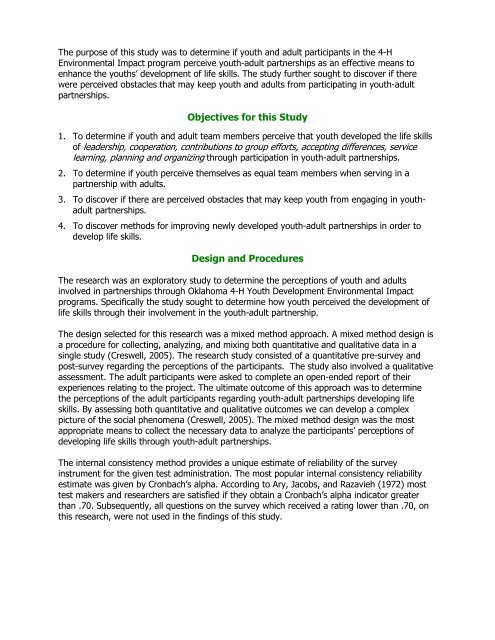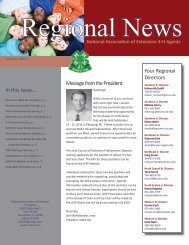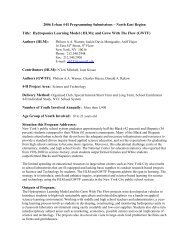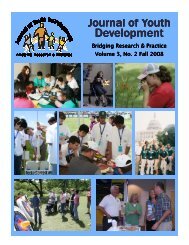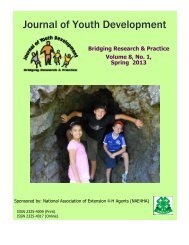Winter 2008 - Vol. 3 No. 3 - National Association of Extension 4-H ...
Winter 2008 - Vol. 3 No. 3 - National Association of Extension 4-H ...
Winter 2008 - Vol. 3 No. 3 - National Association of Extension 4-H ...
- No tags were found...
You also want an ePaper? Increase the reach of your titles
YUMPU automatically turns print PDFs into web optimized ePapers that Google loves.
The purpose <strong>of</strong> this study was to determine if youth and adult participants in the 4-HEnvironmental Impact program perceive youth-adult partnerships as an effective means toenhance the youths’ development <strong>of</strong> life skills. The study further sought to discover if therewere perceived obstacles that may keep youth and adults from participating in youth-adultpartnerships.Objectives for this Study1. To determine if youth and adult team members perceive that youth developed the life skills<strong>of</strong> leadership, cooperation, contributions to group efforts, accepting differences, servicelearning, planning and organizing through participation in youth-adult partnerships.2. To determine if youth perceive themselves as equal team members when serving in apartnership with adults.3. To discover if there are perceived obstacles that may keep youth from engaging in youthadultpartnerships.4. To discover methods for improving newly developed youth-adult partnerships in order todevelop life skills.Design and ProceduresThe research was an exploratory study to determine the perceptions <strong>of</strong> youth and adultsinvolved in partnerships through Oklahoma 4-H Youth Development Environmental Impactprograms. Specifically the study sought to determine how youth perceived the development <strong>of</strong>life skills through their involvement in the youth-adult partnership.The design selected for this research was a mixed method approach. A mixed method design isa procedure for collecting, analyzing, and mixing both quantitative and qualitative data in asingle study (Creswell, 2005). The research study consisted <strong>of</strong> a quantitative pre-survey andpost-survey regarding the perceptions <strong>of</strong> the participants. The study also involved a qualitativeassessment. The adult participants were asked to complete an open-ended report <strong>of</strong> theirexperiences relating to the project. The ultimate outcome <strong>of</strong> this approach was to determinethe perceptions <strong>of</strong> the adult participants regarding youth-adult partnerships developing lifeskills. By assessing both quantitative and qualitative outcomes we can develop a complexpicture <strong>of</strong> the social phenomena (Creswell, 2005). The mixed method design was the mostappropriate means to collect the necessary data to analyze the participants’ perceptions <strong>of</strong>developing life skills through youth-adult partnerships.The internal consistency method provides a unique estimate <strong>of</strong> reliability <strong>of</strong> the surveyinstrument for the given test administration. The most popular internal consistency reliabilityestimate was given by Cronbach’s alpha. According to Ary, Jacobs, and Razavieh (1972) mosttest makers and researchers are satisfied if they obtain a Cronbach’s alpha indicator greaterthan .70. Subsequently, all questions on the survey which received a rating lower than .70, onthis research, were not used in the findings <strong>of</strong> this study.


